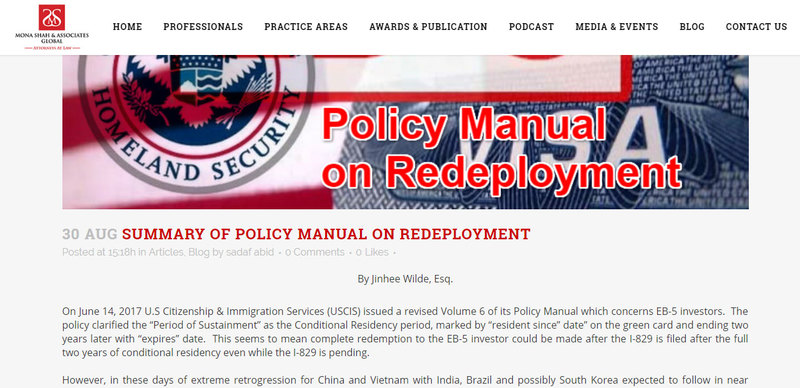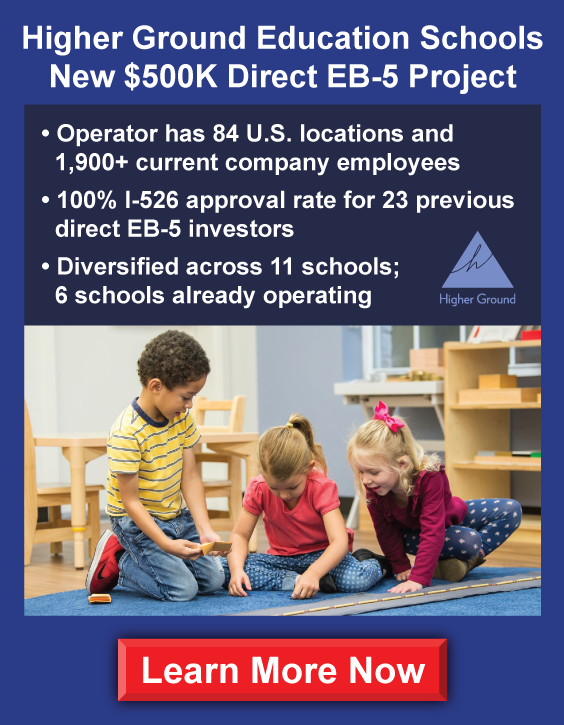On June 14, 2017 U.S Citizenship & Immigration Services (USCIS) issued a revised Volume 6 of its Policy Manual which concerns EB-5 investors. The policy clarified the “Period of Sustainment” as the Conditional Residency period, marked by “resident since” date” on the green card and ending two years later with “expires” date. This seems to mean complete redemption to the EB-5 investor could be made after the I-829 is filed after the full two years of conditional residency even while the I-829 is pending.
However, in these days of extreme retrogression for China and Vietnam with India, Brazil and possibly South Korea expected to follow in near future, what happens to those investors whose sustainment period is not enough during the initial loan maturity date or those who are not even admitted as conditional resident? The Policy Manual says that any redeployment should maintain the “at risk” requirement. For the capital to be “at risk” there must be a risk of loss and a chance for gain.
Nevertheless, the Policy Manual breaks down the “at risk” requirements into two different categories: (1) before the job creation requirement is satisfied and (2) after the job creation requirement is satisfied. If the job creation requirement is not yet met, “the full amount of the investment must be made available to the business most closely responsible for creating the employment upon which the petition is based.” If the job creation requirement has been met, the new commercial enterprise (NCE) may make loans into more residential construction if that was the scope of NCE, or even deploy the investment into “new issue municipal bonds, such as for infrastructure spending” as long as investments into such bonds “are within the scope of the new commercial enterprise in existence at the time the petitioner filed the Immigrant Petition by Alien Entrepreneur (I-526).” and within a commercially reasonable time.
Keep in mind that until 2-3 years ago, the idea of having to redeploy was not contemplated by the EB-5 industry and many, if not most, of the regional centers would not have formed the NCE with the necessary scope language to be able to redeploy easily. Thus, the fact that policy is silent on whether the new activity must be in the same regional center area or targeted employment area as the original project or NCE without a specific scope of how the regional center may redeploy it in other areas is troubling.
If the NCE scope of business changed after I-526 filing, redeployment into a loan similar to the changed scope may not be qualifying redeployment as such change may be considered a “material change.” A “material change” before an investor’s admission in conditional residency would result in denial of the I-526 petition or revocation of an approved petition. Further, the Policy does not define what constitutes “commercially reasonable time.” However, “Reasonable period of time” in the context to create required jobs for I-829 approval is 1 year (less than 3 years after admission as conditional resident), with the exception of “extreme circumstances.” 6 USCIS-PM G.5(B)(2)
Whether redeployment is “consistent with the scope” of the NCE, the investor must review the NCE partnership or operating agreement that describes NCE’s business or activities in the “purposes” or “powers” of the NCE or in a definition section describing Project or Qualifying Investment. Investors may be wise to obtain a second opinion on the redeployment issue from someone other than just a migration agent or the regional center, such as IIUSA best practice guidelines and legal professionals whose interest is to protect the investors.
Invest in the USA (IIUSA) President Bob Kraft notes, “while this Policy Manual has been published more than a year ago, the true effect of the redeployment and how it is administered by the EB-5 industry has not been truly tested. IIUSA is committed to monitoring the industry standard and advising on the best practices of the EB-5 industry to assure the integrity and longevity of the EB-5 program.”
IIUSA representatives are excited come to Seoul this September to host the association’s first-ever Global Banquet Series event in Korea. The banquet, open to any industry stakeholder, will bring together industry leaders for an evening of educational panels, networking and business development and is an excellent opportunity for local EB-5 stakeholders to come learn more about the industry from its one and only trade association.
On behalf of IIUSA, I am pleased to invite you to join us for this important event at the JW Marriott on September 13, 2018 at 6 – 10 pm.
http://mshahlaw.com/summary-policy-manual-redeployment/
Mentions
States
- New York
Videos





Subscribe for News
Site Digest
Join Professionals on EB5Projects.com →
Securities Disclaimer
This website is for informational purposes only and does not constitute an offer or solicitation to sell shares or securities. Any such offer or solicitation will be made only by means of an investment's confidential Offering Memorandum and in accordance with the terms of all applicable securities and other laws. This website does not constitute or form part of, and should not be construed as, any offer for sale or subscription of, or any invitation to offer to buy or subscribe for, any securities, nor should it or any part of it form the basis of, or be relied on in any connection with, any contract or commitment whatsoever. EB5Projects.com LLC and its affiliates expressly disclaim any and all responsibility for any direct or consequential loss or damage of any kind whatsoever arising directly or indirectly from: (i) reliance on any information contained in the website, (ii) any error, omission or inaccuracy in any such information or (iii) any action resulting therefrom.



